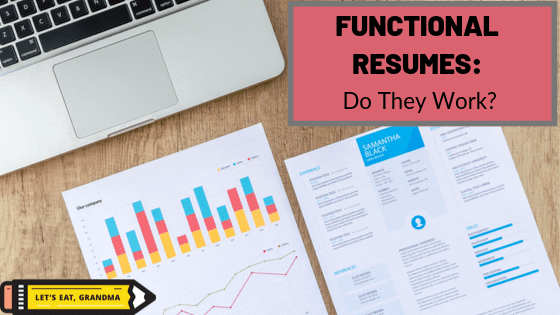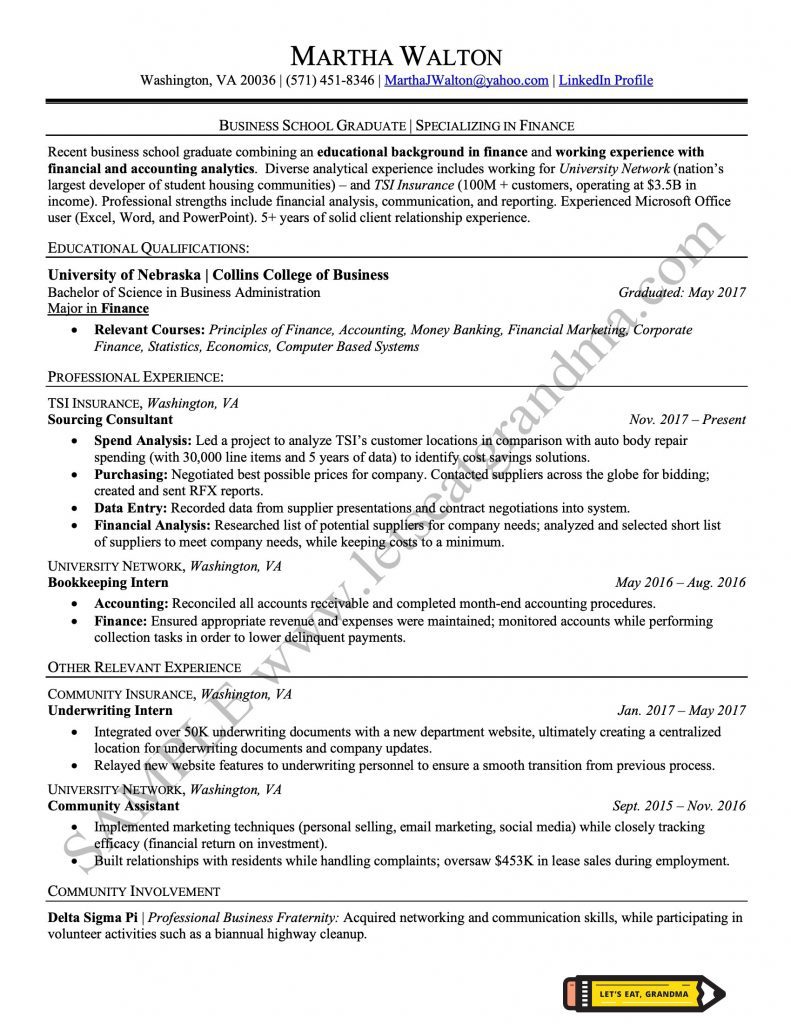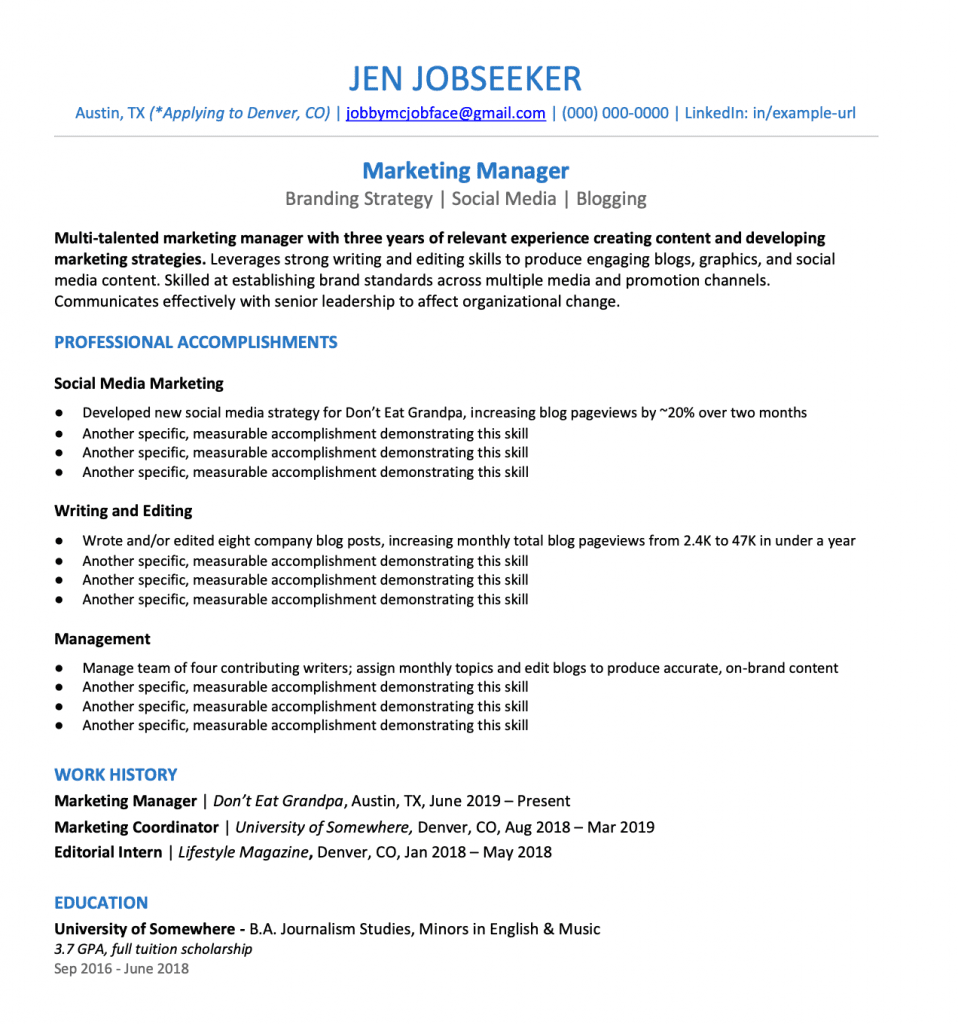Most Functional Resumes Don’t Work. Try This Example Instead.

Are you changing career paths? Jumping back into the industry after a gap? Don’t be so quick to jump to a functional resume format. Read on to find out why you wouldn’t want to write one and see an example of a more effective alternative resume format we wrote.
By: Ashley Dolar | Resume Writer for Let’s Eat, Grandma
Are you working on your resume right now? Are you worried that your work experience might not be a perfect match for the job description? We have some options for you. But before you go any further, you need to know the difference between a traditional resume and a functional resume.
Say what!? Yes, there is more than one way to structure a resume.
You can’t change your skills, achievements, or work experience, but you can change the way you present them. Think of it as your job hunting secret weapon.
Ready for more job search help?
Sign up for a free Senior Writer Resume Critique to see what's holding you back from landing interviews. One of our top professional resume writers will give you personalized feedback on the top 3 items you can improve based on our expert practices!
So, let’s take a closer look at the traditional resume versus the functional resume.
In a traditional (or chronological resume), your work history is presented in the standard, reverse-chronological order. Hiring managers and other HR professionals generally prefer this method because it’s easy to understand and easy to skim. In other words, they know what you bring to the table without much effort on their parts.
But what if you’re lacking industry experience or have gaps in your employment history? That’s okay, especially for new college grads, career switchers, and stay-at-home parents who are looking to re-enter the workforce.
Remember, employers are looking to add value to their team, and even if you don’t have the “perfect” work history, you can still make the cut.
Here’s where an alternative resume format like a functional resume can sound appealing. But don’t jump to using one too quickly.
A functional resume is set up to especially highlight the skills and accomplishments that make you a strong candidate for a specific position while de-emphasizing the details of your work history.
The format that is most commonly referred to as a functional resume starts by listing core competencies with bullets giving examples of each, and simply lists job titles at the bottom of the resume with only the companies, dates, and little or no description. It looks something like this:
Some functional resumes for longer careers don’t even get to the jobs until the second page!
A word of caution…
Functional resumes seem like a promising alternative for anyone concerned about a non-linear career path as they disguise gaps and potential red flags. But beware: they carry a bit of a bad rap with recruiters.
Recruiters prefer seeing your accomplishments organized by jobs, not skills. For one, it helps them to scan faster (and they need to scan quickly), and two, it places your accomplishments in the context of your career.
Plus, there’s a general impression that a functional resume format is meant to hide information. Even if you have a non-linear history, it’s better to be forthright and explain it than to trigger an assumption that it’s worse than it really is.
For these reasons, we typically don’t recommend the common functional resume format. There are several ways to deal with a gap on your resume or writing a career change resume.
There are several other ways that you can vary your formatting from a traditional resume to emphasize your skills above your varied work history. You might write an expanded summary of qualifications with bullets, or you might place your skills, education, or volunteering sections before your professional experience section.
But if you really need to cover a red flag with an alternative resume format…
Enter the two-tier resume: a functional resume alternative
We do have an alternative format that has worked for Let’s Eat, Grandma clients in the past. It still carries a bit of risk and isn’t recommended for everyone, but it can disguise red flags if done properly.
We couldn’t find a commonly used, “official” name for this format, so we colloquially call it the “two-tier” resume. It starts with a summary of qualifications and has a malleable order, but breaks up the professional experience sections into two sections: “Relevant [Industry] Experience” and “Other Professional Experience”. Your jobs are listed chronologically within these sections, but they may not be chronological throughout the resume as a whole.
Like all resume formats, it should be an honest representation of work history, including accurate dates. However, this format gives you leeway to present that information in a different, more prudent order. Of course, you still need to detail your work and/or volunteer experience, but the order is up to you. Say goodbye to the strict timeline format and hello to wiggle room!
Let’s say that you are applying for a position in pharmaceutical sales. With your newfound resume freedom, you can choose to list your three years of media sales experience ahead of your more recent stint as an assistant librarian.

The two-tier resume format may be an option for freelancers with several specialities, among other situations.
Or, let’s say you’re a multi-talented marketing freelancer who’s had several, non-linear jobs in social media marketing, graphic design, and illustration, plus you took a two-year extended sabbatical to pursue a painting career. If you’re now applying for another social media manager job, you can use this format to list “Relevant Social Media Experience” first.
When done correctly, an order like this can show your potential employer that you have the right experience, even if it’s not the most recent.
However, this format is not without its own risks. While not as jarring as the functional resume format, it is still a break from what recruiters are used to, and it could slow their scanning. Plus, some Applicant Tracking Systems have trouble parsing jobs from resumes in non-chronological order, which could hurt your chances of getting noticed in the applicant pool.
For both of these reasons, we suggest reserving the “two-tier” format for situations when you’ve already made a personal contact with the hiring authority who will receive it and/or won’t go through an Applicant Tracking System (ATS). Otherwise, seriously weigh the risk vs. reward of using a traditional format.
Remember, career gaps and other red flags aren’t always dealbreakers, and you should use the techniques mentioned in the previous section before trying this format.
Ready to see an example of a functional resume alternative?

It begins with a professional profile that has been curated for a particular job description. It shows that she has experience in the financial sector and a strong background in building and maintaining client relationships.
Notice the two sections for work experience: we decided to forego the classic chronological order and move experiences that most closely matched the targeted job to the top of her resume. This allowed for the reader to focus on the most important work experiences rather than the other, less meaningful details. And that, job-seekers, is how a small format change can lead to a big job interview.
Is the two-tier resume right for you?
As always: it depends. (I wish I could be more straight-forward, but it really does depend!)
Personally, I’ve used both types of resumes in my 12 years of real-world work experience. I started in marketing, jumped to education, and most recently, landed in freelance writing.
Since my background spans several industries, I usually highlight the most relevant work experience near the top of my resume. That way, a potential employer can see how my qualifications match the job description right away.
So, next time a promising job alert pops up in your notifications, remember that you should stay away from functional resumes, but a two-tier resume may be worth considering. If you still aren’t sure which one is the best route for you, Let’s Eat, Grandma is always here to help.
Ready for more job search help?
Sign up for a free Senior Writer Resume Critique to see what's holding you back from landing interviews. One of our top professional resume writers will give you personalized feedback on the top 3 items you can improve based on our expert practices!

